
This guide describes recommended best practice for managing and operating ocean and inland barges, towboats and tugs that carry and transport crude oil and petroleum products in bulk.
The focus is on operations within the USA, but much of the guidance included may be relevant to barge operations in other regions.
This best practice guide to barge operations in U.S. waters covers all aspects of the management and operation of ocean and inland barges, towboats and tugs that carry and transport crude oil and petroleum products in bulk. Topics covered include:
- Safety management
- certification and documentation
- crew management
- navigation
- cargo, ballast systems and bunkering operations
- ship to ship transfers
- pollution prevention and response.
It is designed to support national and international regulations and recommendations and industry guidelines. Although the focus is on operations within the USA, much of the guidance included may be relevant to barge operations in other regions.
Purpose and scope
This Guide describes recommended best practices for managing and operating ocean and inland barges, towboats and tugs that carry and transport crude oil and petroleum products in bulk. The focus is on operations within the USA, but much of the guidance may be relevant to barge operations in other parts of North America and in other regions.
The Guide builds on the recommendations in accepted industry publications, such as the International Safety Guide for Oil Tankers and Terminals (ISGOTT). Additionally, this Guide is intended to complement any applicable international conventions, national legislation, local laws and Classification Society rules.
Although the Guide is primarily intended for use by tug and barge operators, it may also be of interest to prospective charterers, oil company vetting departments, terminal staff and government officials.
A generic guide such as this is not specific to all types of vessels in all locations. Readers should decide carefully whether to apply the Guide in particular circumstances.
References within the Guide to particular codes should be checked to verify that only the latest editions of the codes are used.
Purpose and scope
Glossary
Abbreviations
Bibliography
Section One: Safety management
Section Two: Certification and documentation
Section Three: Crew management
Section Four: Security and vessel access
Section Five: Navigation, communications and electronics
Section Six: Cargo and ballast systems and procedures
Section Seven: Bunkering operations
Section Eight: Vessel to vessel transfers
Section Nine: Pollution prevention and response
9.1 Emergency response
9.2 Cargo systems and spill containment
9.3 Inspecting and testing of cargo pipes and hoses
9.4 Spill response equipment
9.5 Oil record book
9.6 Garbage management plan
9.7 Vessel General Permit
Section Ten: Fire-fighting and safety equipment
Section Eleven: Mooring and anchoring
Section Twelve: Towing/pushing equipment and procedures
Section Thirteen: Machinery spaces and systems
Section Fourteen: Structural maintenance
The Oil Companies International Marine Forum (OCIMF) is a voluntary association of oil companies with an interest in the shipment and terminalling of crude oil, oil products, petrochemicals and gas. OCIMF focuses exclusively on preventing harm to people and the environment by promoting best practice in the design, construction and operation of tankers, barges and offshore vessels and their interfaces with terminals. Learn more at: www.ocimf.org
- Number of Pages:
- 124
- ISBN:
- 9781856096379
- Binding Format:
- Paperback
- Book Height:
- 210 mm
- Book Width:
- 147 mm
- Weight:
- 0.3 kg
- Author:
Oil Companies International Marine Forum
- Published Date:
- June 2014
- Preview:
- Yes






